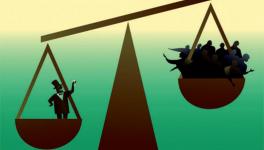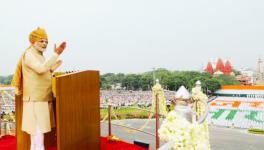It’s Official, the Indian Economy is Running Aground
The official gross domestic product (GDP) data have just been released, which show that the growth rate in the fourth quarter of 2018-19 (January-March) over the fourth quarter of 2017-18 was 5.8%. This is the lowest quarterly growth rate in five years. The media coverage of this event, however, has only been concerned with India’s rivalry with China, i.e., with the fact that India has lost the position of being the fastest-growing economy in the world to China. But while this banal discussion was going on, another figure was released by the government: the official unemployment rate was 6.1% for the year 2018-19, which was the highest rate for the last 45 years.
The government, of course, disputes this claim, of the unemployment rate being the highest in the last 45 years, by arguing that the method of computing unemployment has changed. But the fact that the unemployment rate is disturbingly high, can hardly be disputed.
The unemployment data compiled by the National Sample Survey Organisation (NSSO) had been available with the government for quite some time but were suppressed by the government before the elections. They had been leaked during this period, but there was no confirmation of their authenticity. Now that the elections are over and the government has released the data, the official figures confirm what had been leaked. The abysmal state of unemployment is now officially admitted.
The high unemployment rate is not the direct result of the growth slowdown. The quarterly GDP estimates are based mainly on corporate data; but the unemployment estimates, derived from household interviews, reach a much broader cross-section of the population than those whose fortunes are tied up with the corporate sector. In particular, these reflect what has been happening in the medium and small-scale enterprise sector, which, after agriculture, is the largest employment-generating sector.
So, if unemployment is already so high, and if the quarterly GDP data show a slowing down of the growth rate, then the likelihood is that the unemployment rate will be even higher in the months to come, as the impact of the recession will be reflected across the spectrum, from corporate to medium and small-scale industries. The Indian economy, in short, is running aground.
The government in a neo-liberal economy has very few instruments at its disposal to stimulate the economy. The instrument it can use with impunity is monetary policy; but already two rounds of reduction in interest rate have been announced. Any further reduction in interest rate runs the risk of making India unattractive as a destination for globalised finance; and in such a case, the current account deficit in the balance of payments will be difficult to finance.
Other monetary instruments like lowering the ‘cash reserve ratio’ are also apparently under the consideration of the Monetary Policy Committee of the Reserve Bank of India. But there is no evidence that expenditure has been constrained by a shortage of liquidity; hence, measures of putting more liquidity in the coffers of banks are hardly going to stimulate the economy.
Using fiscal policy is more certain as an instrument for expanding aggregate demand. But in the present case, using fiscal policy would mean, in effect, enlarging the fiscal deficit, since larger taxes on capitalists are not on the agenda in a neo-liberal regime, and taxes on the working people will not lead to any net addition to aggregate demand, as the working people spend the bulk of their incomes anyway. Enlarging the fiscal deficit, however, though it has no adverse effects per se on the economy other than worsening wealth inequality, will be frowned upon by globalised finance. India’s credit-rating will be downgraded and again it may become difficult to obtain adequate financial inflows to cover the current account deficit in the balance of payments.
What the Narendra Modi government is planning to do in this situation, judging by the NITI Aayog chief Rajiv Kumar’s remarks to journalists the other day, is to open up the economy even more, to privatise a whole lot of public sector enterprises, and thereby attract some capital inflow both for combating the recession and for covering the current deficit. But even leaving aside the longer-run implications of these measures, which would mean handing over the “commanding heights” of the economy to foreign corporates, it is not even clear how much of finance such blandishments would attract. New investment is quite low in the world economy, and there is no reason why India should get a disproportionately large share of it; and as for capital inflows for buying public sector assets, the expectations will be for even better terms down the line, for which the potential buyers will wait. The Modi government’s strategy, therefore, is not likely to cut much ice.
Many in the corporate sector are pretending that it is a cyclical slowdown, which means that it would reverse itself automatically in due course. But this claim has no basis whatsoever. The slowdown in growth rate is because of a slowdown in exports, which is a result of the stagnation in the world economy. The export slowdown in turn has affected both domestic consumption and also investment, though there are no doubt autonomous factors too behind the slackening in these other elements of aggregate demand.
Exports, however, constitute the exogenous element, whose ebb and flow causes a similar ebb and flow in the rate of GDP growth. Since exports cannot be augmented in a stagnant world market, what is necessary for stimulating GDP growth is to have an alternative exogenous stimulus, and this can come only from agriculture.
If the Modi government stimulated agricultural growth, that would increase the domestic GDP growth rate both directly and also indirectly by stimulating industrial demand. In addition, it would also make a big difference to the employment situation: the increase in agricultural output will directly stimulate employment, and the increase in demand for other sector’s goods arising from the rise in agricultural incomes will typically stimulate small and medium enterprises, which are much more employment-intensive.
It follows, therefore, that the strategy of a government that is serious about reversing the recession should be to promote agricultural growth. This is not just an anti-recession strategy. The real per capita agricultural income has hardly increased at all during the Modi years compared with what it was in 2013-14 before Modi came to power; and promoting agricultural growth as an anti-recession strategy would have altered this situation.
From every conceivable point of view, therefore, promoting agricultural growth is the optimal strategy at present. But the strategy outlined by the NITU Aayog chief, who reportedly has proximity to Modi, talks of pursuing the neo-liberal strategy with even greater vigour, as the government’s response to the current slowdown.
It may be thought that there is no conflict between the two positions, that the government’s pursuing neo-liberalism with greater vigour does not rule out promoting agricultural growth. Hasn’t the same Modi who wants more vigorous pursuit of neo-liberalism, also said that farmers’ incomes would be doubled by 2022? But these two are mutually exclusive strategies. The pursuit of neo-liberalism necessarily means a squeeze on the petty production sector, including peasant agriculture; and a strengthening of the neo-liberal strategy will mean a further opening up of agriculture to international agribusiness, which will only make matters worse for peasant agriculture.
For a start, promoting agricultural growth would require, among other things, the provision of subsidised credit, and of assured remunerative procurement prices. The provision of higher remunerative prices, if it is not to create an inflationary situation, will have to be accompanied by higher food subsidy. This will enlarge the fiscal deficit, which is anathema for a neo-liberal regime.
Likewise, priority sector lending norms, with subsidised interest rates on the credit, are resented by private banks, especially foreign banks. So, a neo-liberal strategy which privatises the banking sector, is precisely what must be avoided by a government that wishes to make subsidised credit available to agriculture. The basic pre-requisites for stimulating agriculture, especially peasant agriculture, therefore, are ruled out under neo-liberalism. And the intensification of neo-liberalism that the Modi government is promising will hardly increase agricultural growth. The slowdown in the economy, therefore, will only continue.
Get the latest reports & analysis with people's perspective on Protests, movements & deep analytical videos, discussions of the current affairs in your Telegram app. Subscribe to NewsClick's Telegram channel & get Real-Time updates on stories, as they get published on our website.
























